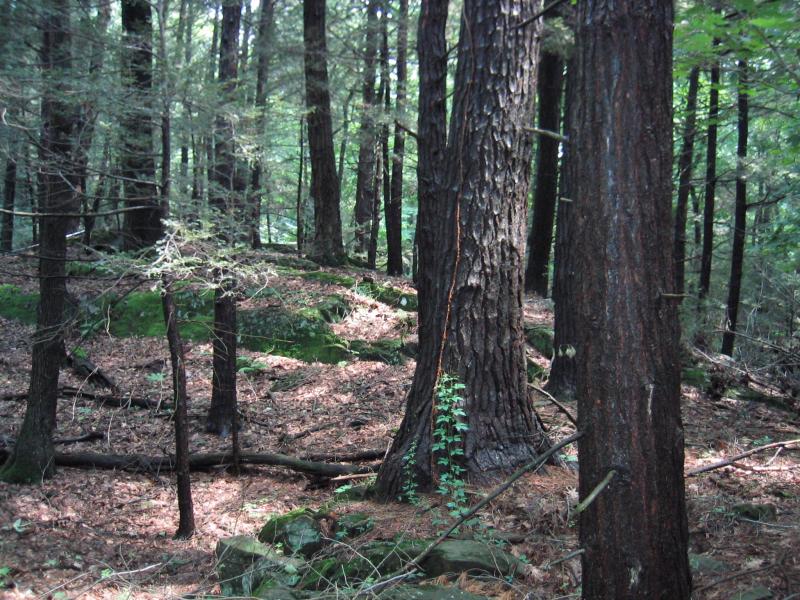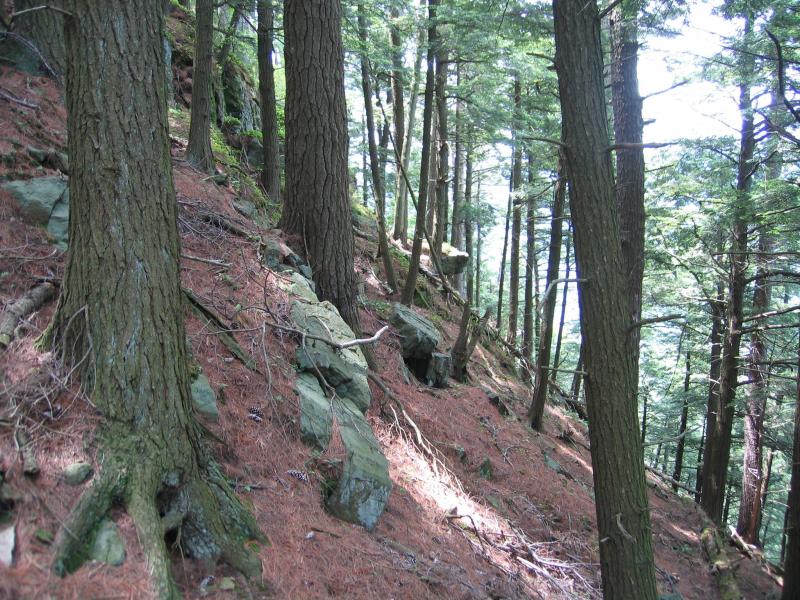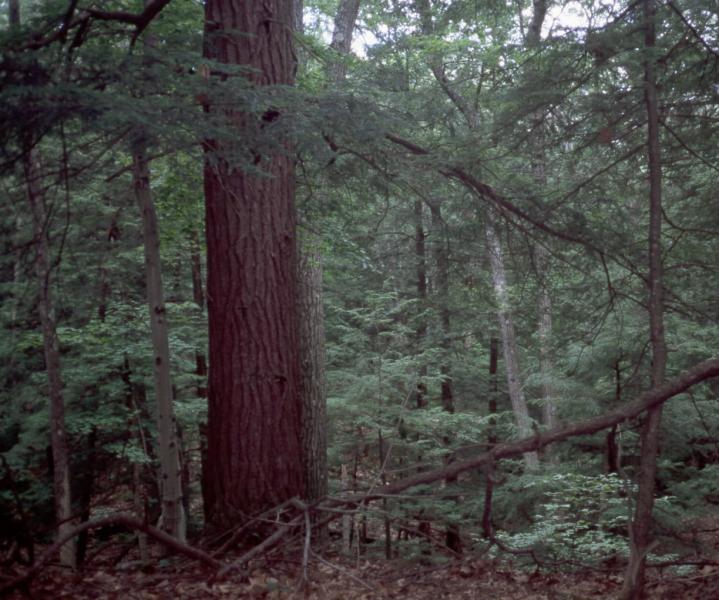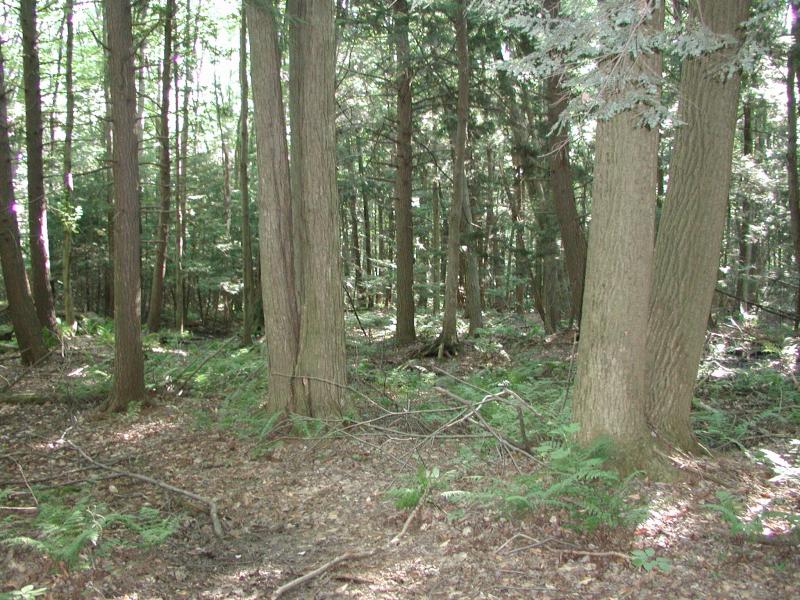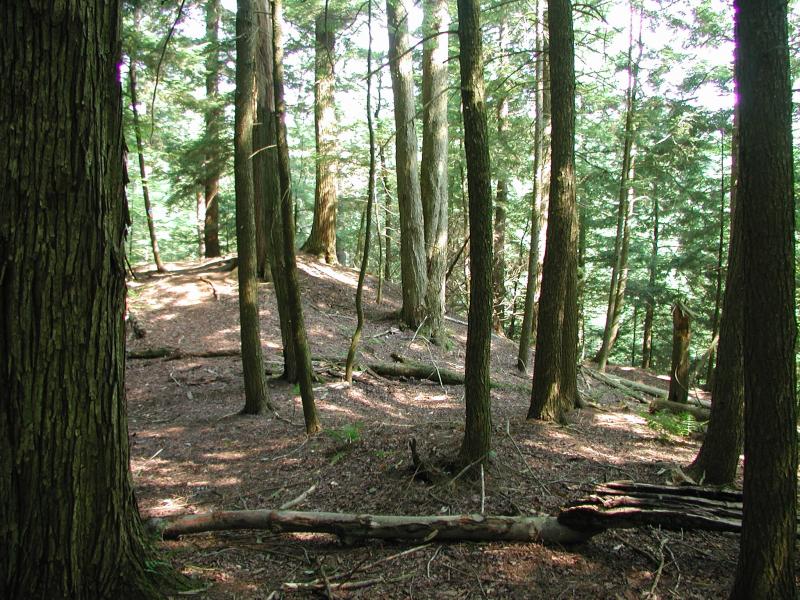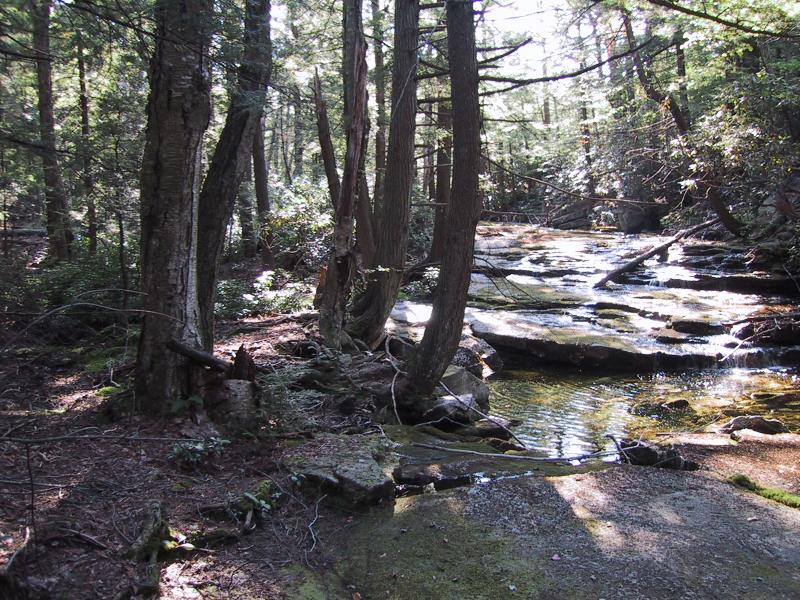Hemlock-Northern Hardwood Forest
- System
- Terrestrial
- Subsystem
- Forested Uplands
- State Protection
- Not Listed
Not listed or protected by New York State.
- Federal Protection
- Not Listed
- State Conservation Status Rank
- S3
Vulnerable in New York - Vulnerable to disappearing from New York due to rarity or other factors (but not currently imperiled); typically 21 to 80 populations or locations in New York, few individuals, restricted range, few remaining acres (or miles of stream), and/or recent and widespread declines.
- Global Conservation Status Rank
- G4G5
Apparently or Demonstrably Secure globally - Uncommon to common in the world, but not rare; usually widespread, but may be rare in some parts of its range; possibly some cause for long-term concern due to declines or other factors. More information is needed to assign either G4 or G5.
Summary
Did you know?
The Nature Conservancy's first preserve was a hemlock-hardwood forest. Mianus River Gorge Preserve, purchased in 1955, is located in Bedford, Westchester County, New York. A majestic stand of 350-year-old hemlock trees, some up to 100 feet tall, are found in the preserve. For information on how to visit the preserve, go to http://www.nature.org/wherewework/northamerica/ states/newyork/preserves/art12419.html.
State Ranking Justification
There are several thousand occurrences statewide. Many documented occurrences have good viability and many are protected on public land or private conservation land. This community has a statewide distribution and includes several very large, high quality, old-growth examples. The current trend of this community is probably declining due to moderate and imminent threats related to hemlock woolly adelgid and development pressure.
Short-term Trends
The number and acreage of hemlock-northern hardwood forests in New York have declined moderately in recent decades as a result of logging, agriculture, and other development. Several examples may have been lost to hemlock woolly adelgid.
Long-term Trends
The number and acreage of hemlock-northern hardwood forests in New York have declined substantially from historical numbers likely correlated with past logging, agiculture, and other development. Several examples may have been lost to hemlock woolly adelgid.
Conservation and Management
Threats
Threats to forests in general include changes in land use (e.g., clearing for development), forest fragmentation (e.g., roads), and invasive species (e.g., insects, diseases, and plants). Other threats may include over-browsing by deer, fire suppression, and air pollution (e.g., ozone and acidic deposition). When occurring as expansive forests, the largest threat to the integrity of hemlock-northern hardwood forests are activities that fragment the forest into smaller pieces. These activities, such as road building and other development, restrict the movement of species and seeds throughout the entire forest, an effect that often results in loss of those species that require larger blocks of habitat (e.g., black bear, bobcat, certain birds). Additionally, fragmented forests provide decreased benefits to neighboring societies of services these societies often substantially depend on (e.g., clean water, mitigation of floods and droughts, pollination in agricultural fields, and pest control) (Daily et al. 1997). Hemlock woolly adelgid (Adelges tsugae) is an exotic species that could potentially have a devastating effect on hemlock trees in New York. This exotic "sap-sucker" has only recently begun to spread through the forests of the northeastern United States. Without control measures, insect-infected trees will probably die within three to four years (McClure et al. 2001, Bishop 2002, Ward et al. 2004). Although current adelgid infestations are primarily confined to southeastern New York, in 2002 adelgid infestation was newly observed in Monroe County (USDA Forest Service 2002).
Conservation Strategies and Management Practices
Management should focus on activities that help maintain regeneration of the species associated with this community. Develop a plan to control or eliminate hemlock woolly adelgid. Deer have been shown to have negative effects on forest understories (Miller et al. 1992, Augustine and French 1998, Knight 2003) and management efforts should strive to ensure that regenerating trees and shrubs are not so heavily browsed that they cannot replace overstory trees. Avoid cutting old-growth examples and encourage selective logging of areas that are under active forestry.
Development and Mitigation Considerations
Strive to minimize fragmentation of large forest blocks by focusing development on forest edges, minimizing the width of roads and road corridors extending into forests, and designing cluster developments that minimize the spatial extent of the development. Development projects with the least impact on large forests and all the plants and animals living within these forests are those built on brownfields or other previously developed land. These projects have the added benefit of matching sustainable development practices (for example, see: The President's Council on Sustainable Development 1999 final report, US Green Building Council's Leadership in Energy and Environmental Design certification process at http://www.usgbc.org/).
Inventory Needs
Inventory any remaining large or old-growth examples across the state.
Research Needs
Regularly assess the presence and degree of impact that hemlock woolly adelgid has on this forest community.
Rare Species
- Aconitum noveboracense (Northern Monkshood) (guide)
- Adoxa moschatellina (Musk Root) (guide)
- Agrimonia rostellata (Woodland Agrimony) (guide)
- Asimina triloba (Pawpaw) (guide)
- Asplenium scolopendrium var. americanum (Hart's-tongue Fern) (guide)
- Astragalus neglectus (Cooper's Milkvetch) (guide)
- Borodinia missouriensis (Green Rock Cress) (guide)
- Callitriche terrestris (Terrestrial Water Starwort) (guide)
- Cardamine rotundifolia (Round-leaved Water Cress) (guide)
- Carex arcta (Northern Clustered Sedge) (guide)
- Carex formosa (Handsome Sedge) (guide)
- Carex jamesii (James' Sedge) (guide)
- Criorhina nigriventris (Bare-cheeked Bumblefly) (guide)
- Crotalus horridus (Timber Rattlesnake) (guide)
- Cypripedium arietinum (Ram's Head Lady's Slipper) (guide)
- Cystopteris protrusa (Lowland Fragile Fern) (guide)
- Diphasiastrum complanatum (Northern Ground Cedar) (guide)
- Emydoidea blandingii (Blanding's Turtle) (guide)
- Eurycea longicauda (Longtail Salamander) (guide)
- Galium concinnum (Shining Bedstraw) (guide)
- Geum macrophyllum var. macrophyllum (Large-leaved Avens) (guide)
- Geum virginianum (Cream-colored Avens) (guide)
- Haliaeetus leucocephalus (Bald Eagle) (guide)
- Hydrangea arborescens (Wild Hydrangea) (guide)
- Lasionycteris noctivagans (Silver-haired Bat) (guide)
- Lasiurus borealis (Eastern Red Bat) (guide)
- Lasiurus cinereus (Hoary Bat) (guide)
- Lindbergia brachyptera (Papillose Fine-branch Moss) (guide)
- Myotis leibii (Eastern Small-footed Myotis) (guide)
- Myotis lucifugus (Little Brown Bat) (guide)
- Myotis septentrionalis (Northern Long-eared Bat) (guide)
- Myotis sodalis (Indiana Bat) (guide)
- Neotoma magister (Allegheny Woodrat) (guide)
- Petasites frigidus var. palmatus (Sweet Coltsfoot) (guide)
- Pieris virginiensis (West Virginia White) (guide)
- Platanthera hookeri (Hooker's Orchid) (guide)
- Pterospora andromedea (Pine Drops) (guide)
- Pyrola asarifolia ssp. asarifolia (Pink Shinleaf) (guide)
- Siphlonurus barbarus (Barbarous Primitive Minnow Mayfly) (guide)
- Sylvilagus transitionalis (New England Cottontail) (guide)
- Tachopteryx thoreyi (Gray Petaltail) (guide)
- Triphora trianthophora (Nodding Pogonia) (guide)
Range
New York State Distribution
This community is currently known from across the state north of the Coastal Plain. Numerous patches of hemlock-northern hardwood forest are known from the Catskill Mountains, the Shawangunk Mountains, the Hudson Highlands, the Rensselaer Plateau, the Adirondack Mountains, the southern Finger Lakes region, and the river valleys that flow into Lake Erie in western New York.
Global Distribution
The range of this community probably spans most of the northern and central Appalachian Mountains, concentrated at the northern end of this range, where "northern" hardwoods are dominant over "southern" hardwoods. This range is estimated to span north to southern Ontario, west to Minnesota, southwest to Ohio and Kentucky, south to Tennessee and North Carolina, and northeast to Nova Scotia.
Best Places to See
- Silver Lake Bog Preserve
- Catskill Park (Ulster County)
- Sterling Forest State Park (Orange County)
- Lake Alice Wildlife Management Area
- Taconic State Park
- Mianus River Gorge Preserve (Westchester County)
- Adirondack Park, Moreau Lake State Park (Warren County)
- Moreau Lake State Park (Saratoga County)
- Iroquois National Wildlife Refuge (Orleans County)
- Robert H. Treman State Park (Tompkins County)
- Minnewaska State Park Preserve (Ulster County)
- Letchworth State Park (Livingston, Wyoming Counties)
Identification Comments
General Description
A mixed forest that typically occurs on middle to lower slopes of ravines, on cool, mid-elevation slopes, and on moist, well-drained sites at the margins of swamps. Eastern hemlock (Tsuga canadensis) is codominant with any one to three of the following tree species: American beech (Fagus grandifolia), sugar maple (Acer saccharum), red maple (A. rubrum), black cherry (Prunus serotina), white pine (Pinus strobus), yellow birch (Betula alleghaniensis), black birch (B. lenta), red oak (Quercus rubra), and basswood (Tilia americana). The relative cover of eastern hemlock is quite variable, ranging from nearly pure stands in some steep ravines to as little as 20% of the canopy cover. Striped maple (Acer pensylvanicum) is often prominent as a mid-story tree. This is a broadly defined and very widespread community with many variants. For example, in the Hudson Valley, eastern hemlock is sometimes codominant with red oak; in the Adirondacks, yellow birch and sugar maple are sometimes codominant.
Characters Most Useful for Identification
A close-canopy forest with eastern hemlock present in the canopy. Hemlock may occur in nearly pure stands, with nearly 100% canopy cover, or reach an abundance as low as 20% canopy cover, intermingled with other canopy trees.
Best Time to See
The sheltered coves that hemlock-northern hardwood forests often inhabit offer a pleasant escape from the leafless deciduous forests in the winter. Throughout the winter, birds can be found foraging in bark crevices and among the green needles of hemlock trees.
Hemlock-Northern Hardwood Forest Images
Classification
International Vegetation Classification Associations
This New York natural community encompasses all or part of the concept of the following International Vegetation Classification (IVC) natural community associations. These are often described at finer resolution than New York's natural communities. The IVC is developed and maintained by NatureServe.
- Eastern White Pine - Eastern Hemlock Lower New England-Northern Piedmont Forest (CEGL006328)
- Eastern White Pine - Eastern Hemlock - Red Spruce Forest (CEGL006324)
- Northern Red Oak - Eastern Hemlock - Tuliptree / American Witch-hazel Forest (CEGL006566)
- Eastern Hemlock - Sugar Maple - American Beech / Intermediate Woodfern Forest (CEGL006639)
- Eastern Hemlock - Yellow Birch - Sugar Maple / Intermediate Woodfern Forest (CEGL006638)
- Eastern Hemlock - (Yellow Birch) - Red Spruce / Bunchberry Dogwood Forest (CEGL006129)
- Eastern Hemlock - American Beech - Northern Red Oak Forest (CEGL006088)
- Eastern Hemlock - Chestnut Oak - Sweet Birch Forest (CEGL006923)
NatureServe Ecological Systems
This New York natural community falls into the following ecological system(s). Ecological systems are often described at a coarser resolution than New York's natural communities and tend to represent clusters of associations found in similar environments. The ecological systems project is developed and maintained by NatureServe.
- Appalachian (Hemlock)-Northern Hardwood Forest (CES202.593)
- Laurentian-Acadian Pine-Hemlock-Hardwood Forest (CES201.563)
Characteristic Species
-
Trees > 5m
- Acer pensylvanicum (striped maple)
- Acer rubrum var. rubrum (common red maple)
- Acer saccharum (sugar maple)
- Betula alleghaniensis (yellow birch)
- Betula lenta (black birch)
- Fagus grandifolia (American beech)
- Fraxinus americana (white ash)
- Ostrya virginiana (hop hornbeam, ironwood)
- Pinus strobus (white pine)
- Quercus alba (white oak)
- Quercus montana (chestnut oak)
- Quercus rubra (northern red oak)
- Tsuga canadensis (eastern hemlock)
-
Shrubs 2 - 5m
- Hamamelis virginiana (witch-hazel)
- Rhododendron maximum (great rose-bay, great laurel)
- Viburnum lantanoides (hobblebush)
-
Shrubs < 2m
- Rubus spp.
- Vaccinium pallidum (hillside blueberry)
- Viburnum acerifolium (maple-leaved viburnum)
-
Herbs
- Aralia nudicaulis (wild sarsaparilla)
- Arisaema triphyllum ssp. triphyllum (common jack-in-the-pulpit)
- Athyrium angustum (northern lady fern)
- Carex pensylvanica (Pennsylvania sedge)
- Dennstaedtia punctilobula (hay-scented fern)
- Dryopteris campyloptera (mountain wood fern)
- Dryopteris intermedia (evergreen wood fern, fancy wood fern, common wood fern)
- Dryopteris marginalis (marginal wood fern)
- Epifagus virginiana (beech-drops)
- Eurybia divaricata (white wood-aster)
- Huperzia lucidula (shining firmoss)
- Hypopitys monotropa (yellow pine-sap)
- Lysimachia borealis (starflower)
- Maianthemum canadense (Canada mayflower)
- Medeola virginiana (Indian cucumber-root)
- Mitchella repens (partridge-berry)
- Monotropa uniflora (Indian-pipe)
- Oxalis montana (northern wood sorrel)
- Polystichum acrostichoides (Christmas fern)
- Streptopus lanceolatus (rose twisted stalk, rose mandarin)
- Thelypteris noveboracensis (New York fern)
- Tiarella cordifolia (foamflower)
- Trillium erectum (purple trillium, stinking Benjamin)
- Uvularia sessilifolia (wild-oats, sessile-leaved bellwort)
- Viola rotundifolia (early yellow violet)
-
Nonvascular plants
- Leucobryum glaucum
Similar Ecological Communities
- Appalachian oak-hickory forest
(guide)
Appalachian oak-hickory forests have less hemlock, sugar maple, and beech than hemlock-northern hardwood forests, but have a higher abundance of oaks and hickories (Carya spp.).
- Beech-maple mesic forest
(guide)
Beech-maple mesic forests have fewer hemlocks than hemlock-northern hardwood forests, but many of the other canopy species are similar.
- Hemlock-hardwood swamp
(guide)
Hemlock-hardwood swamps occur in wet depressions, and often have hollows with standing water, especially during wetter times of the year. Hemlock-northern hardwood forests are more likely to occur on well-drained soils.
- Pine-northern hardwood forest
(guide)
Pine-northern hardwood forests occur in drier, more well-drained soils while hemlock-northern hardwood forests tend to be found in moister areas. Also, pine-northern hardwood forests have more white pine (Pinus strobus) or red pine (P. resinosa), and less hemlock.
Vegetation
Percent cover
This figure helps visualize the structure and "look" or "feel" of a typical Hemlock-Northern Hardwood Forest. Each bar represents the amount of "coverage" for all the species growing at that height. Because layers overlap (shrubs may grow under trees, for example), the shaded regions can add up to more than 100%.
Additional Resources
References
Augustine, A.J. and L.E. French. 1998. Effects of white-tailed deer on populations of an understory forb in fragmented deciduous forests. Conservation Biology 12:995-1004.
Bishop, R.M. 2002. Hemlock enemy #1. Hemlock wooly adelgid. From the Frederick News-Post Horticulture. University of Maryland's Cooperative Extension/ Maryland Master Gardener Program.
Daily, G.C., S. Alexander, P.R. Ehrlich, L. Goulder, J. Lubchenco, P. Matson, H.A. Mooney, S. Postel, S.H. Schneider, D. Tilman, and G.M. Woodwell. 1997. Ecosystem Services: benefits supplied to human societies by natural ecosystems. Issues In Ecology 2:1-16.
Edinger, G. J., D. J. Evans, S. Gebauer, T. G. Howard, D. M. Hunt, and A. M. Olivero (editors). 2014. Ecological Communities of New York State. Second Edition. A revised and expanded edition of Carol Reschke’s Ecological Communities of New York State. New York Natural Heritage Program, New York State Department of Environmental Conservation, Albany, NY. https://www.nynhp.org/ecological-communities/
Edinger, Gregory J., D.J. Evans, Shane Gebauer, Timothy G. Howard, David M. Hunt, and Adele M. Olivero (editors). 2002. Ecological Communities of New York State. Second Edition. A revised and expanded edition of Carol Reschke's Ecological Communities of New York State. (Draft for review). New York Natural Heritage Program, New York State Department of Environmental Conservation. Albany, NY. 136 pp.
Eyre, F.H., ed. 1980. Forest cover types of the United States and Canada. Society of American Foresters, Washington, D.C.
Heimburger, C.C. 1934. Forest-type studies in the Adirondack Region. Cornell University Experiment Station Memoir 165, Ithaca, New York.
Knight, T.M. 2003. Effects of herbivory and its timing across populations of Trillium grandiflorum (Liliaceae). American Journal of Botany 90:1207-1214.
Leopold, Donald J., Carol Reschke, and D.S. Smith. 1988. Old-growth forests of the Adirondack Park, New York. Natural Areas Journal 8: 166-189.
McClure, M.S., S.M. Salom, and K.S. Sheilds. 2001. Hemlock wooly adelgid. United States Department of Agriculture, Forest Service, Forest Health Technology Enterprise Team. Connecticut Agricultural Experiment Station, Windsor, CT.
McIntosh, R.P. 1972. Forests of the Catskill Mountains, New York. Ecol. Monogr. 42:143-161.
McVaugh, R. 1958. Flora of the Columbia County area, New York. Bull. 360. New York State Museum and Science Service. University of the State of New York. Albany, NY. 400 pp.
Miller, S.G., S.P. Bratton, and J. Hadidian. 1992. Impacts of white-tailed deer on endangered and threatened vascular plants. Natural Areas Journal 12:67-74.
New York Natural Heritage Program. 2024. New York Natural Heritage Program Databases. Albany, NY.
Reschke, Carol. 1990. Ecological communities of New York State. New York Natural Heritage Program, New York State Department of Environmental Conservation. Latham, NY. 96 pp. plus xi.
Ross, P. 1958. Microclimatic and vegetational studies in a cold-wet deciduous forest. Black Rock Forest Papers No. 24, Harvard Black Rock Forest, Cornwall-on-the-Hudson, New York.
Shanks, R.E. 1966. An ecological survey of the vegetation of Monroe County, New York. Proc. Rochester Academy Sci. 11:108-252.
United States Department of Agriculture, Forest Service. 2001. Federal guidelines for participating state agencies. Gypsy moth cooperative suppression and eradication projects. United States Department od Agriculture, Forest Service. State and Private Forestry, Forest Health Protection, Northeastern Area and Region 8. Newtown Square, PA.
Ward, J.S., M.E. Montgomery, C.A.S.-J Cheah, B.P. Onken, and R.S. Cowles. 2004. Eastern hemlock forests: Guidelines to minimize the impacts of hemlock wooly adelgid. NA-TP-03-04. The Connecticut Agricultural Experiment Station, New Haven, CT; USDA Forest Service, Northeastern Research Station, Hamden, CT, and USDA Forest Service, Northeastern Area State and Private Forestry, Morgantown, WV.
Links
About This Guide
This guide was authored by: Timothy G. Howard
Information for this guide was last updated on: February 5, 2024
Please cite this page as:
New York Natural Heritage Program. 2024.
Online Conservation Guide for
Hemlock-northern hardwood forest.
Available from: https://guides.nynhp.org/hemlock-northern-hardwood-forest/.
Accessed July 26, 2024.
